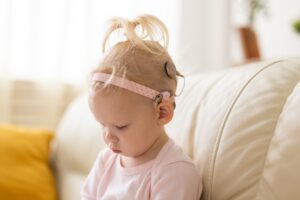By Christine Hemelians, MS, OTR/L
Quality sleep is important and beneficial for everyone; however, it’s especially important for babies and toddlers. Sleep plays a crucial role in the development of mental and physical health for children. It impacts alertness and attention, cognitive performance, language and vocabulary acquisition, and learning and memory (Pacheco & Vyas, 2023). Furthermore, napping for toddlers is vital as well as it supports memory consolidation, executive function, and motor skill development. The American Academy of Pediatrics (AAP) recommends the minimum and maximum hours each age group should sleep during a 24-hour period:
- Age 4-12 months: 12-16 hours (including naps)
- Age 1-2 years: 11-14 hours (including naps)
- Age 3-5 years: 10-13 hours (including naps)
- Age 6-12 years: 9-12 hours
- Age 13-18 years: 8-10 hours
About 10-20% of infants and young children do not get the recommended hours of sleep on a consistent basis; most sleep in short spurts and have difficulty staying asleep for longer periods (Schafer-Clay, 2023). If your child struggles with sleep here are some things to consider: 1) quality of sleep, 2) how long does it take for my child to fall asleep?, 3) how often does my child wake up throughout the night?, 4) Does my child have inconsistent sleep patterns? There’s a high incidence of sleep issues with children with neuro-differences (i.e. Autism or ADHD). A study in 2019 found that about 80% of autistic preschoolers have disrupted sleep and that sleep problems are twice as common among children with autism as they are among typical children (Furfaro, 2020). Many people with autism or ADHD may struggle with sensory sensitivities to light, sound, or touch, which may contribute to difficulty sleeping. With regards to sleep and ADHD, this disorder impairs the regulation of brain activity that often affects sleep patterns, which often result in an increased time to fall asleep, increased likelihood of sleep disturbances, as well as risk of sleep deprivation.
Sleep is an important part of a child’s occupation and is necessary for daily participation and optimal health. One of the key strategies, which is crucial for adequate sleep hygiene, is for the family to establish and execute a consistent bedtime routine for their child.
Below are recommendations and strategies to promote good sleep hygiene:
- Establish a bedtime routine- as the parent, you can control what this routine entails. For example, the routine can begin with a light bedtime snack, bath time which includes a deep lotion massage, brushing teeth, reading a bedtime story, and lights out.
- Outdoor time- it is crucial for your child to have physical activity embedded throughout the day
- Indoor activity (i.e. heavy work strategies or deep pressure input)- evening activity should occur about 1-2 hours before bed
- Limit screen time- stop screen time at least 1.5 hours before bedtime routine begins
- Light snacks that are calming- crunchy foods (i.e. pretzel sticks or warm toast), beef jerky, nut butter on a spoon with unsalted crackers, apple (whole or sliced) with nut butter, sucking a thick drink (i.e. yogurt or smoothie) from thick straw)
- No caffeine after lunch- certain snacks that are targeted to kids/ teens often contain caffeine such as: Cliff bar Vanilla Almond Latte or Dannon Lowfat Coffee yogurt,
- Don’t sleep with pets
Once you’ve established a consistent bedtime routine, consider your child’s specific sensory needs and setup the sleep environment for success addressing each of the sensory systems.
Touch/tactile:
- Comfortable room temperature
- Type of mattress firmness
- Bedding/ sheets used
- Type of PJs worn
- Deep weighted blanket or no blanket; weighted stuffed animal
- Hugs (deep pressure)
Visual:
- Night light vs. no night light
Auditory:
- Sound machine vs. no sound at all
- Consider your child’s room location (is there too much noise pollution outside?)
Olfactory: (smell)
- Use of essential oils




